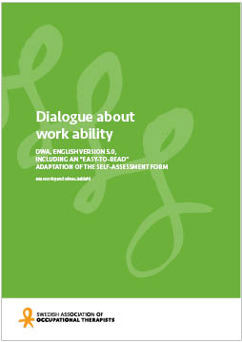New version in June 2023
The first English translation of the DWA manual was published in 2007 and revisions were made in 2012 and 2020. This is the new version 5.0/2023.
In this revised manual, the chapters on development and research, the two cases, the mapping to ICF and the references have been updated. The manual has also been supplemented with an ”easy-to-read” adaptation of the self-assessment form.
About the DWA
The instrument Dialogue about Work Ability (DWA) is designed by the occupational therapists Eva Norrby and Iréne Linddahl. The DWA has been used in Sweden since 2001 (original Swedish title: Dialog om arbetsförmåga, DOA).
The DWA provides a great deal of support both for the client and the occupational therapist in assessing the person’s ability to work and work-related interventions. The purpose of DWA is to provide an overall picture of a person’s resources and limitations in relation to work or work-related activities.
The instrument focuses on participation through a person’s self-assessment of his/her ability to work (appendix A1 - original self-assessment form and appendix A2 - "easy-to-read" adaptation of the self-assessment), as well as in the dialogue with an occupational therapist on the results of self-assessment and the occupational therapist assessment (appendix B - summary form). Repeated assessments can lead to changes in the person’s ability to work, being traced in relation to the goals formulated in the rehabilitation plan.
Development and use
One starting point for the development was the lack of tools to assess an individual’s ability to work, above all for the large number of people with long-term sick-leave. The instrument has undergone validity and reliability testing with favorable results (Linddahl, Norrby & Bellner, 2003; Norrby & Linddahl, 2006, Linddahl, 2007).
DWA is intended to be used in the mapping and assessment of work ability, as well as to set goals and follow up work-oriented interventions for persons. DWA can also be used to measure changes in work ability at group level. The target group is persons of working age. DWA is based on the perspective of activity, and not on specific diagnoses.
DWA has a person-centered approach and is based on Model of Human Occupation (MOHO). Also the items of DWA have been mapped to concepts in International Classification of Function, Disability and Health (ICF).
Content and structure
DWA consists of 34 questions (items) linked to ICF codes and divided into five areas:
- Self-awareness, interests and values.
- Roles and habits.
- Physical ability.
- Organisational and problem-solving ability.
- Ability to interact and communicate.
The rating is based on a Likert scale with levels of option 1-5, from low degree (1) to high degree (5). DWA is comprised of two parts: one for self-assessment to be filled in by the client and one for assessment by the user (occupational therapist), independent of that by the person. In direct connection to each question are spaces for the person’s and the occupational therapist’s respective comments.
The instrument also includes a summary form, which the user fills in during a follow-up dialgue) with the person that takes place after both assessments have been completed. Finally, two cases are included in the manual:
- Alex, 35 year old, with stress and addiction problems
- Maryam, 54 years old, with chronic pain syndrome
Order and translation inquiries
Order the manual
Contact Tina Sandulf with complete invoice address. When ordering outside the Nordic countries a proforma invoice should be paid aforehead.
Translation inquiries
Contact Tina Sandulf and describe the purpose of and the plan for the translation.
